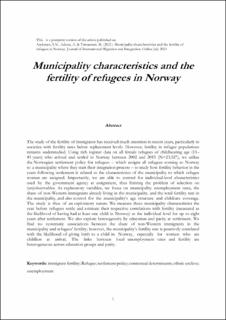| dc.description.abstract | Abstract The study of the fertility of immigrants has received much attention in recent years, particularly in societies with fertility rates below replacement levels. However, fertility in refugee populations remains understudied. Using rich register data on all female refugees of childbearing age (15–45 years) who arrived and settled in Norway between 2002 and 2015 (N=23,527), we utilize the Norwegian settlement policy for refugees—which assigns all refugees coming to Norway to a municipality where they start their integration process—to study how fertility behavior in the years following settlement is related to the characteristics of the municipality to which refugee women are assigned. Importantly, we are able to control for individual-level characteristics used by the government agency at assignment, thus limiting the problem of selection on (un)observables. As explanatory variables, we focus on municipality unemployment rates, the share of non-Western immigrants already living in the municipality, and the total fertility rate in the municipality, and also control for the municipality’s age structure and childcare coverage. The study is thus of an exploratory nature. We measure these municipality characteristics the year before refugees settle and estimate their respective correlations with fertility (measured as the likelihood of having had at least one child in Norway) at the individual level for up to 8 years after settlement. We also explore heterogeneity by education and parity at settlement. We fnd no systematic associations between the share of non-Western immigrants in the municipality and refugees’ fertility; however, the municipality’s fertility rate is positively | en_US |
